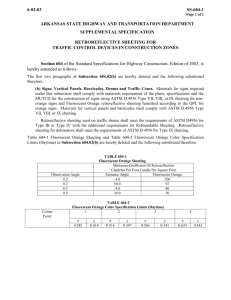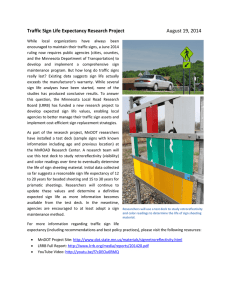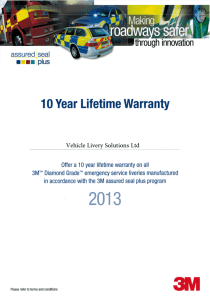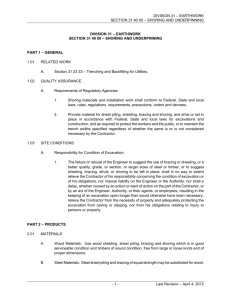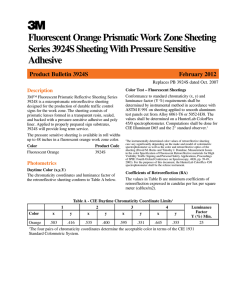3 Diamond Grade™ DG
advertisement
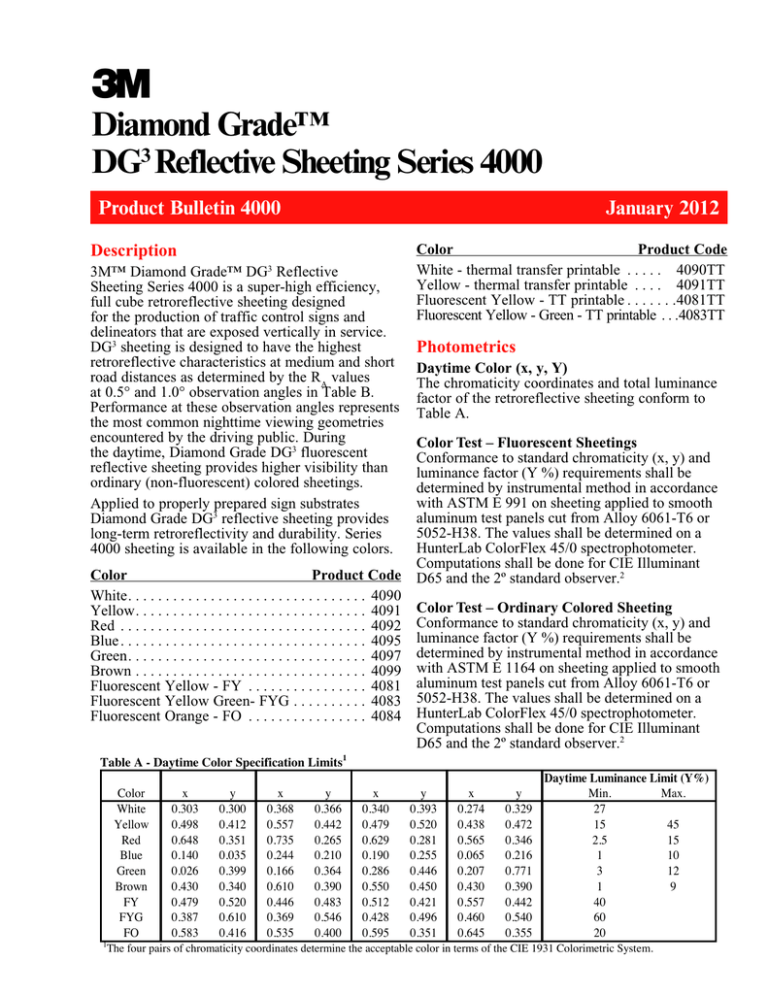
3 Grade™ Diamond 3 Diamond Grade™ DG Reflective Sheeting Series 4000 3 DG Reflective Sheeting Series 4000 Product Bulletin 4000 January 2012 Product Bulletin 4000 July 2011 Description 3M™ Diamond Grade™ DG3 Reflective Description Sheeting Series 4000 is a 3super-high efficiency, 3M™ Diamond Grade™ DG Reflective Sheeting full cube retroreflective sheeting designed Series 4000 is a super-high efficiency, full cube and for the production of traffic control signs retroreflective sheeting designed for the production delineators that are exposed vertically in service. of 3traffic control and delineators that DG sheeting is signs designed to have the are highest 3 sheeting is and short exposed vertically in service. DG retroreflective characteristics at medium designed to have the highest retroreflective road distances as determined by the RA values at medium and short road in distances atcharacteristics 0.5° and 1.0° observation angles TableasB. determined by the RA values at 0.5° and 1.0° Performance at these observation angles represents observation angles in Table B. Performance at these the most common nighttime viewing geometries observation angles represents the most common encountered by the driving public. During nighttime viewing geometries encountered by the 3 the daytime, DG fluorescent driving public.Diamond During theGrade daytime, Diamond Grade reflective sheeting provides higher visibility reflective sheeting provides higher than DG3 fluorescent ordinary colored sheetings. visibility (non-fluorescent) than ordinary (non-fluorescent) colored sheetings. Applied to properly prepared sign substrates Diamond Grade DG3 reflective sheeting provides Applied to retroreflectivity properly prepared sign long-term andsubstrates durability. Series 3 reflective provides colors. Diamond Grade DG 4000 sheeting is available insheeting the following Color Replaces PB 4000 dated JulyProduct Code 2009 White - thermal transfer printable . . . . . 4090TT Color Product Code Yellow - thermal transfer printable . . . . 4091TT White - thermalYellow transfer -printable 4090TT Fluorescent TT printable. . . . . . . 4081TT Yellow - thermal transfer printable Fluorescent Yellow - Green - TT4091TT printable . . . 4083TT Photometrics Photometrics Daytime Color (x, y, Y) Daytime Colorcoordinates (x, y, Y)and total luminance The chromaticity The chromaticity coordinates totaltoluminance factor of the retroreflective sheeting and conform factor Table A.of the retroreflective sheeting conform to Table A. Color Test – Fluorescent Sheetings Color Test –toFluorescent Sheetings Conformance standard chromaticity (x, y) and Conformance chromaticity luminance factor to (Ystandard %) requirements shall be (x, y) and luminance (Y %)method requirements shall be determined byfactor instrumental in accordance with ASTM Eby 991instrumental on sheeting applied to smooth determined method in accordance aluminum test panels Alloy 6061-T6 with ASTM E 991cut onfrom sheeting applied or to smooth 5052-H38. The shall befrom determined a aluminum testvalues panels cut Alloyon6061-T6 or HunterLab ColorFlex 45/0 spectrophotometer. 5052-H38. The values shall be determined on a ComputationsColorFlex shall be done45/0 for CIE Illuminant HunterLab spectrophotometer. 2 long-term retroreflectivity and durability. Series 4000 D65 and the 2º standard observer. Computations shall be done for CIE Illuminant sheeting is available in the following colors. Color Product Code D65 and the 2º standard observer.2 Test – Ordinary Colored Sheeting White���������������������������������������������������������������� 4090 Color Conformance standard chromaticity y) and Color Product Code Test –toOrdinary Colored(x, Sheeting Yellow�������������������������������������������������������������� 4091 Color White 4090 luminance factor (Y %) requirements shall be (x, y) and to standard chromaticity Red ������������������������������������������������������������������ 4092 Conformance Yellow 4091 determined by instrumental method in accordance factor (Y %) requirements shall be Blue������������������������������������������������������������������ 4095 luminance Red 4092 with ASTM E 1164 on sheeting applied to smooth determined by instrumental method in accordance Green���������������������������������������������������������������� 4097 Blue 4095 aluminum test panels cut from Alloy 6061-T6 or with ASTM E 1164 on sheeting applied to smooth Brown�������������������������������������������������������������� 4099 Green 4097 5052-H38. The values shall be determined on a aluminum test panels cut from Alloy 6061-T6 or Fluorescent Yellow FY �������������������������������� 4081 Brown 4099 HunterLab ColorFlex 45/0 spectrophotometer. 5052-H38. The beIlluminant determined on a Fluorescent Yellow GreenFYG�������������������� 4083 Fluorescent Yellow - FY 4081 Computations shallvalues be doneshall for CIE 2 HunterLab ColorFlex 45/0 spectrophotometer. Fluorescent Orange FO �������������������������������� 4084 Fluorescent Yellow Green- FYG 4083 D65 and the 2º standard observer. Computations shall be done for CIE Illuminant Fluorescent Orange - FO 4084 D65 and the 2º standard observer.2 Table A - Daytime Color Specification Limits1 1 Color White Yellow Red Blue Green Brown FY FYG FO x 0.303 0.498 0.648 0.140 0.026 0.430 0.479 0.387 0.583 y 0.300 0.412 0.351 0.035 0.399 0.340 0.520 0.610 0.416 x 0.368 0.557 0.735 0.244 0.166 0.610 0.446 0.369 0.535 y 0.366 0.442 0.265 0.210 0.364 0.390 0.483 0.546 0.400 x 0.340 0.479 0.629 0.190 0.286 0.550 0.512 0.428 0.595 y 0.393 0.520 0.281 0.255 0.446 0.450 0.421 0.496 0.351 x 0.274 0.438 0.565 0.065 0.207 0.430 0.557 0.460 0.645 y 0.329 0.472 0.346 0.216 0.771 0.390 0.442 0.540 0.355 Daytime Luminance Limit (Y%) Min. Max. 27 15 45 2.5 15 1 10 3 12 1 9 40 60 20 The four pairs of chromaticity coordinates determine the acceptable color in terms of the CIE 1931 Colorimetric System. The instrumentally determined color values of retroreflective sheeting can vary significantly depending on the make and model of colorimetric spectrophotometer as well as the color and retroreflective optics of the sheeting (David M. Burns and Timothy J. Donahue, Measurement Issues in the Color Specification of Fluorescent Retroreflective Materials for High Visibility Traffic Signing and Personal Safety Applications, Proceedings of SPIE: Fourth Oxford Conference on Spectroscopy, 4826, pp. 39-49, 2003). For the purposes of this document, the HunterLab ColorFlex 45/0 spectrophotometer shall be the referee instrument. Printed Colors and Overlay Films Coefficients of Retroreflection (RA) The values in Table B are minimum coefficients of retroreflection expressed in candelas per lux per square meter (cd/lux/m2). Entrance Angularity Performance in Regard to Orientation 2 For screenprinted or thermally transfer printed transparent color areas on white sheeting when processed according to 3M recommendations, the coefficients of retroreflection shall not be less than 70% of the value for the corresponding color in Table B. For white sheeting covered with 3M™ ElectroCut™ Film Series 1170 when processed according to 3M recommendations, the coefficients of retroreflection shall not be less than 100% of the value for the corresponding color in Table B. The color chromaticity and luminance shall conform to Table A on page 1. Diamond Grade DG3 Reflective Sheeting is designed to be an effective wide angle reflective sheeting regardless of its orientation on the substrate or ultimate orientation of the sign after installation. However, because the efficiency of light return from cube corner reflectors is not equal at all application orientations, especially with increasing entrance angles, it is possible to get the widest entrance angle light return when the sheeting is oriented in a particular manner. When high entrance angle (>50º) performance is required for given signs (e.g. Keep Right Symbols), it can be obtained easily by specifying the application orientation of the completed signs. In these situations the completed sign should have the sheeting positioned at the 0º orientation (downweb direction perpendicular to the road). When the “primary groove line” (or, flat side of the diamond shape) is vertical in the completed sign, sheeting is said to be at a 0º orientation. When the “primary groove line” (or, flat side of the diamond shape) is horizontal in the completed sign, the sheeting is said to be at a 90º orientation. (Figure 1) Test for Coefficients of Retroreflection Conformance to coefficient of retroreflection requirements shall be determined by instrumental method in accordance with ASTM E-810 “Test Method for Coefficient of Retroreflection of Retroreflective Sheeting”, and per E-810 the values of 0º and 90º rotation are averaged to determine the RA in Table B. Table B - Minimum Coefficient of Retroreflection RA for new sheeting (cd/lux/m2) -4º Entrance Angle3 White Yellow Red Green Blue Brown Fluorescent Yellow Fluorescent Yellow Green Fluorescent Orange Observation Angle4 0.2º 0.5º 1.0º 580 420 120 435 315 90 87 63 18 58 42 12 26 19 5 17 13 4 350 250 72 460 340 96 175 125 36 30º Entrance Angle3 White Yellow Red Green Blue Brown Fluorescent Yellow Fluorescent Yellow Green Fluorescent Orange 0.2º 220 165 33 22 10 7 130 180 66 0.5º 150 110 23 15 7 5 90 120 45 1.0º 45 34 7 5 2 1 27 36 14 Figure 1 Entrance Angle – The angle from the illumination axis to the retroreflector axis. The retroreflector axis is an axis perpendicular to the retroreflective surface. 4 Observation Angle – The angle between the illumination axis and the observation axis. 3 2 Unless the sign location and/or position calls for extra-wide entrance angularity performance, signs and applied copy (letters, arrows, borders and shields) can be fabricated and installed using the application orientation that most efficiently utilizes the reflective sheeting. Note: For multi-panel signs it is recommended that all background panels be sheeted such that the sheeting direction is the same for all panels. Fabrication Lines The manufacture of prismatic sheeting results in lines being present in the product. In Diamond Grade DG3 sheeting these lines are slightly thicker than the seal pattern legs. Fabrication lines are noticeable in shop light but are not observable on the road either in daylight or at night under typical use conditions (Figure 2). Figure 2 - Fabrication Lines Adhesive Diamond Grade DG3 sheeting has a pressuresensitive adhesive that is recommended for application at temperatures of 65ºF (18ºC) or higher. Adhesive and Film Properties Standard Test Panels Unless otherwise specified herein, sheeting shall be applied to test panels and conditioned in accordance with ASTM D4956 and test methods and conditions shall conform to ASTM D4956. Properties The following properties shall conform to the requirements in ASTM D4956. 1. Adhesion 2. Outdoor weathering - retained coefficient of retroreflection - colorfastness 3. Shrinkage 4. Flexibility 5. Liner removal 6. Impact resistance 7. Night time color In addition, DG3 sheeting will conform to the following properties. 1. Gloss Test Method – Test in accordance with ASTM D523 using a 60º glossmeter. Requirement – Rating not less than 50. 2. Optical Stability Test Method – Apply a 3-inch x 6-inch sample to a test panel. Measure RA then place it in an oven at 71º C ± 3º C (160ºF ± 5ºF) for 24 hours followed by conditioning at standard conditions for two hours. 3 Remeasure RA. Requirement – The sheeting shall retain a minimum of 85% and a maximum of 115% of the original coefficient of retroreflection. Sign Fabrication Methods Application Diamond Grade DG3 sheeting incorporates a pressure sensitive adhesive and should be applied to the sign substrate at temperature of 65ºF/18ºC or higher by any of the following methods: Mechanical squeeze roll applicator – refer to 3M Information Folder (IF) 1.4. Application to extrusions that are edge wrapped requires sufficient softening of the sheeting. This can be accomplished by directing additional heat to the “next to last” edge roller. This practice will increase productivity and minimize cracking. Hand squeeze roll applicator – refer to 3M IF 1.6. Application of Diamond Grade DG3 sheeting for complete signs or backgrounds must be done with a roll laminator, either mechanical or hand driven. Hand Application Hand application is recommended for legend and copy only. Refer to 3M Information Folder 1.5 for more details. Hand applications will show some visual irregularities, which are objectionable to aesthetically critical customers. These are more noticeable on darker colors. To obtain a close-up uniform appearance, a roll laminator must be used. All direct applied copy and border MUST be cut at all metal joints and squeegeed at the joints. Splices Series 4000 sheeting must be butt spliced when more than one piece of sheeting is used on one piece of substrate. The sheeting pieces should not touch each other. This is to prevent buckling as the sheeting expands in extreme temperature and humidity exposure. Double Faced Signs The sheeting on the bottom side of a double faced sign can be damaged if rolled through a squeeze roll applicator with an unprotected steel bottom roller. The use of a semi-soft flat sheet between the steel roller and the applied sign face will provide protection from damage. A material such as a rubber mat, tag board or cardboard is recommended. Substrates Care should be taken to avoid flexing DG3 sheeting before and especially after screening to eliminate the possibility of cracking from improper handling techniques. For traffic sign use, substrates found to be most reliable and durable are properly prepared aluminum sheets and extrusions. Users are urged to carefully evaluate all other substrates for adhesion and sign durability. Other substrates that may be satisfactory for proper application of sheeting will have the following characteristics: – Clean – Smooth – Flat – Rigid – Dimensionally stable – Weather resistant – Non-porous – High surface energy (passes water break test) Refer to Information Folder 1.7 for surface preparation recommendations. Substrates with low surface energy may require additional preparation such as flame treatment, mechanical abrasion or use of adhesion promoters prior to sheeting application. Guide sign extrusions may be edge wrapped. Flat panels or unwrapped extrusions are to be carefully trimmed so that sheeting from adjacent panels does not touch on assembled signs. Diamond Grade DG3 sheeting is designed primarily for applications to flat substrates. Any use that requires a radius of curvature of less than five inches should also be supported by rivets or bolts. Plastic substrates are not recommended where cold shock performance is required. Sign failures caused by the substrate or improper surface preparation are not the responsibility of 3M. 3MTM ElectroCutTM Film 3M™ ElectroCut™ Film Series 1170 may be used to provide transparent colored background copy for traffic control signs on Diamond Grade DG3 sheeting. Refer to Product Bulletin 1170 for fabrication procedures. Imaging Cutting Thermal Transfer Printing Diamond Grade DG3 TT sheeting may be imaged with 3MTM Thermal Transfer Ribbon Series TTR2300 in conjunction with the Matan SprinG3 or Matan Spot4 thermal transfer printers. For regulated traffic signs, Series TTR2300 Spot Traffic Colors are to be applied using these printers and must be covered with 3MTM ElectroCutTM Film 1170. Refer to Product Bulletin TTR2300 for more information. Applied Cut-Out Copy Diamond Grade DG3 cut letters may be applied to a DG3 sheeting background to create a sign legend. Such cut-out copy may be directly applied to the background sheeting, or may be applied in a demountable form. Direct applied copy must be cut at all panel seams and carefully trimmed back so that sheeting from adjacent panels does not touch on assembled signs. Refer to Information Folder 1.10 for more information. Note: It is recommended to fabricate all but the largest signs using 1170 electronic cuttable overlay film instead of direct applied copy. Diamond Grade DG3 sheeting may be cut into letters and shapes of at least three inches in height and stroke widths of at least one half inch. Smaller sizes are not recommended. Sealing cut edges of DG3 sheeting is not required. Diamond Grade DG3 sheeting may be processed into traffic signs by any of the imaging methods described below. 3M assumes no responsibility for failure of sign face legends or backgrounds that have been processed with non-3M process colors or matched component imaging materials other than those listed below. Plotter Cutting Programmable knife cut (electronic cutting) 1. Flat bed plotters can either die cut or kiss cut and offer the most consistent and reliable performance. 2. Friction Fed plotter. Kiss cut only. Success has been achieved using plotters that have 600 grams of down force and a 60º cutting blade. Additional drive wheels may need to be added to improve tracking. An alternative procedure is to cut sheeting from the liner side. Blade force and knife depth must be set to score but not cut through the topfilm. Break apart individual copy or apply premask to retain spacing. Screen Processing Diamond Grade DG3 sheeting may be screen processed into traffic signs before or after mounting on a sign substrate, using 3M Process Colors Series 880I or Series 880N. Series 880I or 880N process colors can be screened at 60-100ºF (16-38ºC) at relative humidity of 20-50%. A PE 157 screen mesh with a fill pass is recommended. Refer to Information Folder 1.8 for details. No clear coating is required or recommended. Use of other process colors series is not recommended. 4 Health and Safety Information Other Cutting Methods Diamond Grade DG3 sheeting may be hand cut or die cut one sheet at a time, and band sawed or guillotined in stacks. Cutting equipment such as guillotines and metal shears, which have pressure plates on the sheeting when cutting, may damage the optics. Padding the pressure plate and easing it down onto the sheets being cut will significantly reduce damage. Maximum stack height for cutting Series 4000 sheeting is 1½ inch or 50 sheets. Details on cutting can be found in Information Folder 1.10. Read all health hazard, precautionary and first aid statements found in the Material Safety Data Sheet and/or product label of any materials prior to handling or use. General Performance Considerations The durability of Diamond Grade DG3 sheeting and finished signs using 3M Matched Component materials will depend upon substrate selection and preparation, compliance with recommended application procedures, geographic area, exposure conditions, and maintenance. Maximum durability of Diamond Grade DG3 sheeting can be expected in applications subject to vertical exposure on stationary objects when processed and applied to properly prepared aluminum according to 3M recommendations provided in Information Folder 1.7. The user must determine the suitability of any nonmetallic sign backing for its intended use. Sign failures caused by the substrate or improper surface preparation are not the responsibility of 3M. Applications to unprimed, excessively rough or non-weather resistant surfaces or exposure to severe or unusual conditions can shorten the performance of such applications. Signs in mountainous areas that are covered by snow for prolonged periods may also have reduced durability. 3M process colors and ElectroCut™ Film, when used according to 3M recommendations, are generally expected to provide performance comparable to colored reflective sheeting. Custom colors, certain lighter colors, heavily toned colors or blends containing yellow or gold may have reduced durability. Atmospheric conditions in certain geographic areas may result in reduced durability. Periodic sign inspection and regular sign replacement are strongly recommended in order for sign owners to establish their own effective service life expectation, beyond the warranty period. Storage and Packaging 3M Diamond Grade DG3 Sheeting should be stored in a cool, dry area, preferably at 65-75ºF (18-24ºC) and 30-50% relative humidity and should be applied within one year of purchase. Rolls should be stored horizontally in the shipping carton. Partially used rolls should be returned to the shipping carton or suspended horizontally from a rod or pipe through the core. Unprocessed sheets should be stored flat. Finished signs and applied blanks should be stored on edge. Screen processed signs must be protected with SCW 568 slipsheet paper. Place the glossy side of the slipsheet against the sign face and pad the face with closed cell packaging foam. Double faced signs must have the glossy side of the slipsheet against each face of the sign. Unmounted screened faces must be stored flat and interleaved with SCW 568 slipsheet, glossy side against the sign face. Avoid banding, crating, or stacking signs. Package for shipment in accordance with commercially accepted standards to prevent movement and chafing. Store sign packages indoors on edges. Panels or finished signs must remain dry during shipment and storage. If packaged signs become wet, unpack immediately and allow signs to dry. Refer to Information Folder 1.11 for instructions on packing for storage and shipment. 3M Basic Product Warranty and Limited Remedy Installation Nylon washers are required when twist style fasteners are used to mount the sign. 3M™ Diamond Grade™ DG3 Reflective Sheeting Series 4000 (“Product”) is warranted to be free of defects in materials and manufacture at the time of shipment and to meet the specifications stated in this Product Bulletin. If DG3 Sheeting is proven not to have met the Basic Warranty on its shipment date, then a buyer’s exclusive remedy, and 3M’s sole obligation, at 3M’s option, will be refund or replacement of the sheeting. Cleaning Signs that require cleaning should be flushed with water, then washed with a detergent solution and soft bristle brush or sponge. Avoid pressure that may damage the sign face. Flush with water following washing. Do not use solvents to clean signs. Refer to 3M Information Folder 1.10. 5 General Warranty Terms: Additional Warranty & Limited Remedy for Ordinary colored Product 1. 3M makes the Additional Warranty (as defined below) as to any traffic control and guidance sign in the United States and Canada (“Sign”) made with 3M™ Diamond Grade™ DG3 Reflective Sheeting Series 4000 (“Product”) and the Matched Component materials listed in Table E. Any Additional Warranty is contingent on all components involved in that Additional Warranty being stored, applied, installed, and used only as 3M recommends in its Product Bulletins and Other Product Information. 2. The Basic Warranty and any applicable Additional Warranty are collectively referred to as the “3M Warranty.” EXCEPT TO THE EXTENT PROHIBITED BY APPLICABLE LAW, THE 3M WARRANTY IS MADE IN LIEU OF ALL OTHER WARRANTIES, RIGHTS OR CONDITIONS, EXPRESS OR IMPLIED, INCLUDING, BUT NOT LIMITED TO, ANY IMPLIED WARRANTY OF MERCHANTABILITY, FITNESS FOR A PARTICULAR PURPOSE AND THOSE ARISING FROM A COURSE OF DEALING, CUSTOM OR USAGE OF TRADE. A BUYER IS RESPONSIBLE FOR DETERMINING IF A PRODUCT IS SUITABLE FOR ITS PARTICULAR PURPOSE AND APPLICATION METHODS. 3. A Sign’s failure to meet the 3M Warranty must be solely the result of the Product or the matched component materials’ design or manufacturing defects. 3M has no obligation under the 3M Warranty if a sign failure is caused by: improper fabrication, handling, maintenance or installation; non-vertical applications where the Sign face is more than +/- 10% from vertical; use of any material or product not made by 3M or not included in Table E; use of application equipment not recommended by 3M; failure of sign substrate; loss of adhesion due to incompatible or improperly prepared substrate; exposure to chemicals, abrasion and other mechanical damage; snow burial or any other sign burial; collisions, vandalism or malicious mischief. 4. 3M reserves the right to determine the method of replacement, and any replacement Product will have the remainder of the original Product’s unexpired 3M Warranty. Claims made under this warranty will be honored only if –The Sign was dated upon completion of fabrication (“Fabrication Date”) using a permanent method (sticker, permanent marker or crayon, metal stamp, etc.) –3M is notified of a 3M Warranty claim during any applicable Warranty Period and the owner or fabricator provides the information reasonably required by 3M to verify if a 3M Warranty is applicable. 1. The Additional Warranty for a Sign made with ordinary colored Product is that the Sign will: (a) remain effective for its intended use when viewed from a moving vehicle under normal day and night driving conditions by a driver with normal vision, and (b) after cleaning, will meet the minimum values for coefficient of retroreflection stated in Table C for Table C’s applicable Warranty Period measured from the Sign’s Fabrication Date. Table C – Minimum Percent Retained of Table B Initial RA for applicable Warranty Period for Ordinary Colors (white, yellow, red, green, blue and brown) Warranty Period Minimum Percentage RA Retained 1-7 Years 8-12 Years 80% 70% 2. If any Sign made with Ordinary Product is proven not to have met the Additional Warranty, then a buyer’s exclusive remedy, and 3M’s sole obligation, at 3M’s option: (a) if this occurs within seven years after the Fabrication Date, then 3M will, at its expense, restore the Sign’s surface to its original effectiveness; or (b) if this occurs during the remainder of the Additional Warranty Period, then 3M will furnish only the necessary 3M sheeting Product and matched component materials quantity to restore the Sign’s surface to its original effectiveness. Additional Warranty & Limited Remedy for Fluorescent Product 1. The Additional Warranty for a Sign made with Fluorescent Product is that the Sign will: (a) remain effective for its intended use when viewed from a moving vehicle under normal day and night driving conditions by a driver with normal vision; (b) after cleaning, will retain 70% of the minimum values for coefficient of retroreflection stated in Table B for the applicable Warranty Period stated in Table D, measured from Fabrication Date; and (c) after cleaning, the fluorescent Product will maintain daytime luminance equal to or greater than the minimums specified in Table A. 6 Table D – Warranty Period for Fluorescent Colors. Table E. Matched Component Materials. Matched Components Color Warranty Period Fluorescent Yellow Fluorescent Yellow Green Fluorescent Orange 10/7 Years5 10/7 Years5 3 Years Process Colors Series 880I Process Colors Series 880N Thermal Transfer Ribbons – Spot Traffic Series TTR2300 Colors only* ElectroCutTM Film Series 1170 Premium Protective Series 1160 Overlay Film Slipsheet SCW 568 Prespacing Tape SCPS-2 Premasking Tape SCPM-3 Transfer Tape TPM-5 * Must be covered with 3M™ ElectroCut™ Film 1170 Due to climatic conditions, Signs in Alabama, Arizona, Florida, Georgia, Hawaii, Louisiana, Mississippi, New Mexico, South Carolina and Texas have the 7-year Additional Warranty Period. 2. If a Sign made with Fluorescent Product is proven not to have met the Additional Warranty, then a buyer’s exclusive remedy, and 3M’s sole obligation, at 3M’s option: (a) for those Fluorescent Products with a 10-year Additional Warranty Period, 3M will, at its expense: (a) restore the Sign’s surface to its original effectiveness if this occurs within seven years after the Fabrication Date; or (b) furnish only the necessary 3M Fluorescent Product and matched component materials quantity to restore the Sign’s surface to its original effectiveness if this occurs during the remainder of the Warranty Period. (b) for those Fluorescent Products with a 7-year Additional Warranty Period, 3M will, at its expense: (a) restore the Sign’s surface to its original effectiveness if this occurs within five years after the Fabrication Date; or (b) furnish only the necessary 3M Fluorescent Product and matched component materials quantity to restore the Sign’s surface to its original effectiveness if this occurs during the remainder of the Warranty Period. (c) for those Fluorescent Products with a 3-year Additional Warranty Period, 3M will furnish only the necessary Fluorescent Product and matched component materials quantity to restore the Sign’s surface to its original effectiveness. 5 Refer to 3M Information Folders and Product Bulletins for detailed information about recommended application procedures and equipment. Other Product Information Always confirm that you have the most current version of the applicable Product Bulletin, Information Folder or Other Product Information. IF 1.4 Instructions for Interstate Squeeze Roll Applicator IF 1.5 Hand Application Instructions IF 1.6 Hand Squeeze Roll Applicator IF 1.7 Sign Base Surface Preparation IF 1.8 Process Color Application Instructions IF 1.10 Cutting, Premasking, and Prespacing IF 1.11 Sign Maintenance Management PB 880I Process Color 880I PB 880N Process Color 880N PB 1170 ElectroCutTM Film PB TTR2300 Thermal Transfer Ribbons Series TTR2300 PB 1160 Protective Overlay Film 1160 7 Limitation of Liability 3M WILL NOT UNDER ANY CIRCUMSTANCES BE LIABLE TO A BUYER FOR DIRECT (other than the applicable Limited Remedy stated above), SPECIAL, INCIDENTAL, INDIRECT OR CONSEQUENTIAL DAMAGES (INCLUDING, WITHOUT LIMITATION, LOSS OF PROFITS) IN ANY WAY RELATED TO A PRODUCT OR THIS PRODUCT BULLETIN, REGARDLESS OF THE LEGAL OR EQUITABLE THEORY ON WHICH SUCH DAMAGES ARE SOUGHT. ASTM Test Methods are available from ASTM International, West Conshohoken, PA. 3M assumes no responsibility for any injury, loss or damage arising out of the use of a product that is not of our manufacture. Where reference is made in literature to a commercially available product, made by another manufacturer, it shall be the user’s responsibility to ascertain the precautionary measures for its use outlined by the manufacturer. Important Notice All statements, technical information and recommendations contained herein are based on tests we believe to be reliable, but the accuracy or completeness thereof is not guaranteed, and the following is made in lieu of all warranties, or conditions express or implied. Seller’s and manufacturer’s only obligation shall be to replace such quantity of the product proved to be defective. Neither seller nor manufacturer shall be liable for any injury, loss or damage, direct, special or consequential, arising out of the use of or the inability to use the product. Before using, user shall determine the suitability of the product for his/her intended use, and user assumes all risk and liability whatsoever in connection therewith. Statements or recommendations not contained herein shall have no force or effect unless in an agreement signed by officers of seller and manufacturer. 3M and Diamond Grade are trademarks of 3M. Used under license in Canada. 3 Traffic Safety Systems Division 3M Canada Company 3M México, S.A. de C.V. 3M Center, Building 0235-03-A-09 P.O. Box 5757 Av. Santa Fe No. 55 St. Paul, MN 55144-1000 London, Ontario N6A 4T1 Col. Santa Fe, Del. Alvaro Obregón 1-800-553-1380 1-800-3MHELPS México, D.F. 01210 www.3M.com/tss Please recycle. © 3M 2011. All rights reserved. Bolger 12010104 Electronic Only
